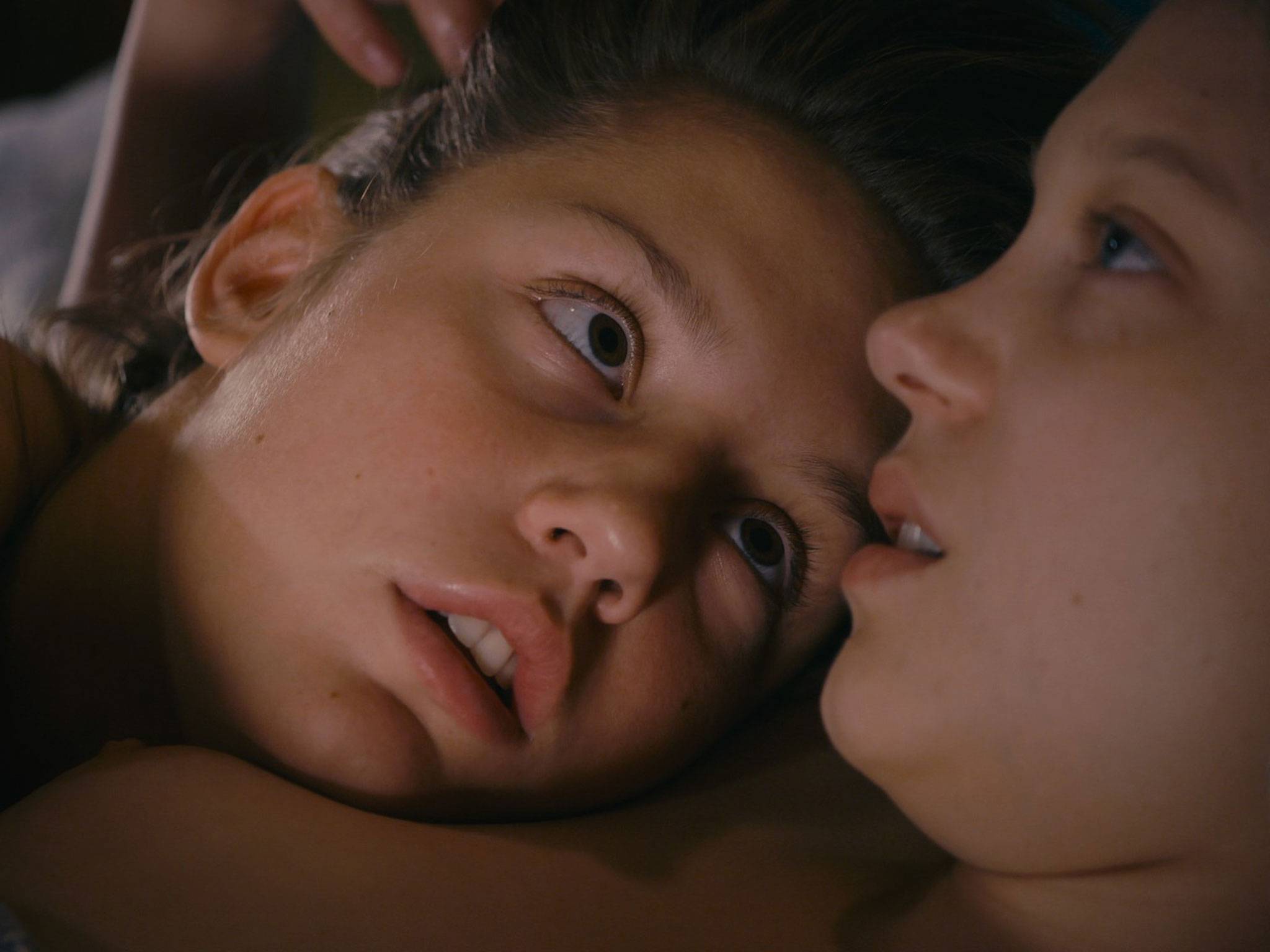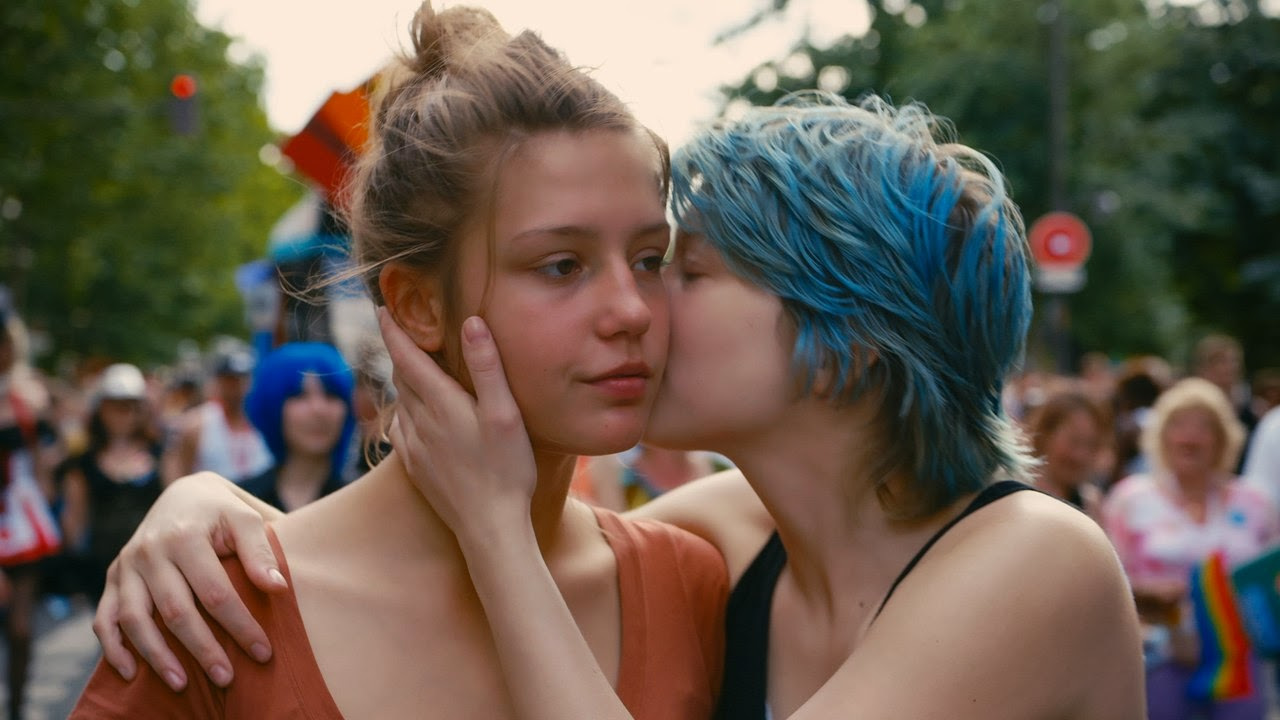Adèle (Léa Seydoux) and Emma (Adèle Exarchopoulos) lounge in a sun-dabbled park, flirting in feints at the close of a tentative first date. Few watching Blue is the Warmest Color (dir. Abdellatif Kechiche, 2013) might be surprised by what happens next: Emma, the blue-haired, older lover of the film, and Adèle, its hungry, coming-of-age lead, kiss.
Now that the wall of apprehension around their relationship has broken, they leap swiftly from first base directly home, the camera cutting straight to Adèle’s bedroom. There, the lovers fall into an aerobic collage of kisses and tangled embraces. Most audiences were unprepared for the scene’s strikingly unconcerned carnality or its unheard-of length (at ten minutes, the sex scene is the film’s the longest). The scene is a bellwether moment; its proponents celebrate the film, while those in opposition often dismiss the movie altogether—some, such as poet and writer Eileen Myles, even walked out of Blue in anger and disbelief.
With its much-talked about sex scenes, Blue has thrown open a critical yet myopic debate about authority, sex, porn, and the male gaze. A cause célèbre at Cannes last year, Blue entered the festival with a rush of anticipation, and in a matter of right place and time, its story of the passionate yet doomed relationship between two young Frenchwomen screened as France’s Parliament voted to legalize same-sex marriage. But Blue threw a lightning rod into that discussion, with many feminist and queer critics finding it a troubling if not altogether prurient film. The New York Times film critic Manohla Dargis put the problem this way: “the movie feels far more about Mr. Kechiche’s desires than anything else.” And Julie Maroh, whose graphic novel of the same name was the basis for the film, felt the sex scenes fell into pornographic territory.
Apparently some critics even timed the movie’s most provocative scene—in which Adèle and Emma tumble and groan, kiss and scissor each other—pegging the scene anywhere between seven and 20 minutes. Tellingly, no other sex scene was measured, although many last just as long; Blue’s sex scenes last, on average, around 10 minutes. That a lot of people were uncomfortable, taken aback, or struck by what Kechiche was doing in that scene—showing in tantalizing detail what we’re rarely shown in film—is due both to its novelty (a 10-minute chess scene would have felt conspicuously long) and its subject. It would have been a shock if audiences were not upset, angry, or perturbed.
Unsurprisingly, Blue received an NC-17 rating. In American films, depictions of violence and gore often get a pass; they’re accepted with an R rating and warning, while sex and nudity are held to a different standard. Scolds on the left like to paint this as puritanical. But what many such critics ignore, perhaps because they do not like it, is that America has a history (and a lingering present) of violence. That our culture treats depictions of violence with kid gloves all the while cracking the whip on nudity is quite consistent with our cinematic morals: America is not France.
It makes sense then that the Motion Picture Association of America fears sex far more than it does bloody death. A gory murder on screen invites gawking, but rarely little thought. Sex is infinitely more complex and more dangerous: sex poses questions, renders tangible sensation; it incites and disturbs. A sex scene will turn you on, or else make you feel ashamed, as if you watched something you shouldn’t have.
And yet, filmmakers have long used sex to explore these feelings and effects. The history of cinema is marked by art house and transgressive films that have boldly used sex as its subject and story: Last Tango in Paris; Salò, or the 120 Days of Sodom; Pola X; The Idiots. Released in 1978, Nagisa Oshima’s In the Realm of the Senses remains, in its uncensored version, banned in Japan. Even today, its depiction of unsimulated carnality would cause audiences to blush. (A particularly infamous scene depicts a character inserting a hard-boiled egg into his lover’s vagina.) More recently, in 2003, Vincent Gallo’s The Brown Bunny drew ire and boos from the crowd at Cannes. While many felt the whole movie was a bust, it was its final scene of Gallo receiving fellatio from star Chloë Sevigny that provoked much of the post-credits backlash.
Of course, sex is messy and unpredictable, vivid and exhilarating—sex scenes should reproduce this anarchy of feelings. That Blue is the Warmest Color has been attended by claims of pornography, voyeurism, and sexual gratuity is testimony to the unruly power and dimension of sex, as well as to the legitimacy of these critiques. Typically, sex is suggested, not shown, in films—and where it is shown, women’s orgasms usually occur too quickly and the sex lasts briefly, while audiences rarely see a man going down on a woman, let alone a woman going down on another. And yet the sex in Blue can appear too plotted and coached; perhaps Kechiche projects his own hetero male fantasy of lesbian sex into the movie—as Dargis points out in her review, Kechiche seems rather enamored with Seydoux’s rump.
But too many commentators commit a cardinal error when responding to the length of the film’s big sex scene; they mistake it for being long and indulgent instead of equivalent and generous. Blue dares to treat Adèle’s sex life as essential and cinematic as any other part of her life; her public life is directly linked to and influenced by her private one. It begs the question: why isn’t there more sex in other movies?
The author and journalist Katie Roiphe came to a similar feeling with respect to contemporary American literature, disappointed by the current kings of American literature. Compared to the writers of the past generation—the thorny, horny class of Roth, Mailer, and Updike—the new generation of David Eggers, David Foster Wallace, et al. appear to recoil from sex. In her essay “The Naked and the Conflicted” she writes, “In contrast to their cautious, entangled, ambivalent, endlessly ironic heirs, there is something almost romantic in the old guard’s view of sex: it has a mystery and a power, at least. It makes things happen.” They weren’t perfect. Roth undoubtedly wrote with some “garden-variety sexism.” Mailer was Mailer. But with sex they explored and exposed themselves to danger, throwing their marriages, doubts, and accustomed ways of life into turmoil. “Why don’t we look at these older writers,” Roiphe asks, “who want to defeat death with sex, with the same fondness as we do the inventors of the first, failed airplanes, who stood on the tarmac with their unwieldy, impossible machines, and looked up at the sky?”
The problem, and the potential reward, is that there’s a lot at risk when you deal with sex, especially in cinema. “Such a level of revelation [in sex or nude scenes] renders a performer so vulnerable as to risk making them close off and shut down their emotional sensitivity…or else, if they remain fully alive to the moment, they’re likely to give more of themselves (of their inner selves) on screen than anyone can or should ever be asked to give, and it’s likely to take a toll on their careers and even their lives,” New Yorker film critic Brody writes, citing the sad cases of Marlon Brando and Maria Schneider. Neither was quite the same after their roles in Last Tango in Paris; Brando’s career lurched into self-oblivion. Schneider suffered a mental breakdown after filming, feeling “raped,” humiliated by Brando and Bertolucci, Tango’s director. Remembering her after Schneider’s death from cancer in 2011, Brody wrote that she gave “more on-screen than any performer should ever be asked to give.” Not quite as severe, both Léa Seydoux and Adèle Exarchopoulos have firmly said they will never again work with Kechiche; Seydoux called filming the movie “horrible.” By their account, Kechiche was a difficult, fiercely fastidious director, demanding numerous takes—allegedly over a hundred—and “blind trust.”
In earlier times, Kechiche and his supporters might have been able to make an argument about the necessity of transgression—“Nothing that is expressed is obscene. What is obscene is what is hidden,” as Oshima said decades ago. This no longer applies, especially not in a world of easy-access internet porn; little today remains hidden. But sex still tugs a cart of custom taboos—sex that is fine in books, but not films; sex that one can discuss or watch in company (and sex that one can only watch alone); sex that is fine if 30 seconds long, but outrageous at three minutes; sex in the light, and sex in the dark.
In Blue is the Warmest Color, Kechiche makes no such distinction; its sex is all part of the same singular story. Not everyone will be pleased by his film, but Kechiche was right to be audacious. Sex has perhaps been portrayed more knowingly and intimately than it has in Blue, but rarely has it been filmed so fully and openly, of its own interior world, and yet, at the same time, connected to the rest of the world.
If anything is to be learned from Blue is the Warmest Color, perhaps it’s this: don’t settle for substandard sex scenes. As generations grow more accustomed to viewing and talking about sex, cinema is going to change. Lars von Trier’s upcoming movie Nymphomaniac is already set to spark countless debates. And remember, 50 Shades of Grey is going to be a film. This could be the start of a mainstream sexual revolution in cinema.





Pingback: weekly reads: global lgbt issues and talking about identity « Delete the Adjectives
lesbian sex looks like bloody hard work. i’m glad to be a gay man, just kneel and smile!!!!!!!!!!!!